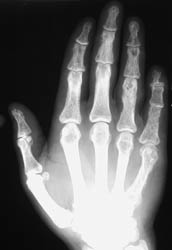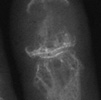
 Sarcoid is a multisystemic disease of unknown etiology which results in noncaseating
granulomas found throughout various organ systems including the osseous structures.
This process occurs approximately ten times more frequently within the black
population with an increased female predominance.
Sarcoid is a multisystemic disease of unknown etiology which results in noncaseating
granulomas found throughout various organ systems including the osseous structures.
This process occurs approximately ten times more frequently within the black
population with an increased female predominance.
Distribution:
The hands are the most common site of osseous involvement. The middle and
distal phalanges and less frequently the proximal phalanges and metatacarpals
may show changes associated with sarcoidosis. Involvement at the wrist occurs
much less frequently.
Radiographic Appearance:
An abnormal trabecular lace-like pattern of destruction can often be seen
at the phalanges and metacarpals of the hands. Cystic changes and osseous
destructive lesions may also be evident. Acro-osteosclerosis with the radiographic
appearance of terminal phlangeal sclerosis is not specific; however, it has
been reported in up to half of the patients with skeletal abnormalities of
sarcoidosis. Soft tissue swelling, and inflammatory skin nodules (erythema
nodosum) are occasionally noted. If the wrist is involved, cystic changes
and lytic lesions may be present.
Differential Diagnosis:
The abnormal trabecular pattern of destruction at the hands is fairly characteristic of sarcoidosis. If osseous destruction is present at the distal phalanges, the appearance may be similar to findings associated with scleroderma. However, scleroderma has fairly characteristic associated soft tissue findings which distinguish it from sarcoidosis.







